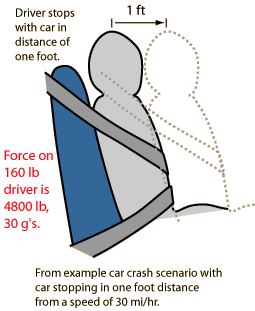 1. According to a research report from the National Highway Traffic and Safety Administration (NHTSA), seatbelts save approximately 13,000 lives in the United States each year. Furthermore, the NHTSA estimates that 7,000 U.S. car accident fatalities would have been avoided if the victims had been wearing seatbelts. I think this figure applies to Malaysia too, with some uncertainty maybe around 1-5% but still, it can save your live.
1. According to a research report from the National Highway Traffic and Safety Administration (NHTSA), seatbelts save approximately 13,000 lives in the United States each year. Furthermore, the NHTSA estimates that 7,000 U.S. car accident fatalities would have been avoided if the victims had been wearing seatbelts. I think this figure applies to Malaysia too, with some uncertainty maybe around 1-5% but still, it can save your live.2. While seatbelts do occasionally contribute to serious injury or death, nearly all safety experts agree that buckling up dramatically increases your chances of surviving an accident. According to the NHTSA, seatbelts reduce the risk of death for a front seat car occupant by about 50 percent. You may not believe what I'm saying but this is not what I'm saying, this is based on the research.
3. When you think about it, this is absolutely amazing: How can a piece of fabric end up being the difference between life and death? What does it actually do? Have you even wonder? In this post, I'll try examine the technology of seatbelts to see why they are one of the most important technologies in any car.
4. The basic idea of a seatbelt is very simple: It keeps you from flying through the windshield or hurdling toward the dashboard when your car comes to an abrupt stop. But why would this happen in the first place? In short, because of inertia. "Dude, what the heck is inertia?"
5. Inertia is an object's tendency to keep moving until something else works against this motion. To put it another way, inertia is every object's resistance to changing its speed and direction of travel. Things naturally want to keep going. You drive 100 km/h and inertia want to keep it at 100 km/h. Anything that is in the car, including the driver and passengers, has its own inertia, which is separate from the car's inertia. The car accelerates riders to its speed. Imagine that you're coasting at a steady 100 km/h. Your speed and the car's speed are pretty much equal, so you feel like you and the car are moving as a single unit.
6. But if the car were to crash into a telephone pole, it would be obvious that your inertia and the car's were absolutely independent. The force of the pole would bring the car to an abrupt stop, but your speed would remain the same. Without a seatbelt, you would either slam into the steering wheel at 100 km/h or go flying through the windshield at 100 km/h. Just as the pole slowed the car down, the dashboard, windshield or the road would slow you down by exerting a tremendous amount of force.
7. It is a given that no matter what happens in a crash, something would have to exert force on you to slow you down. But depending on where and how the force is applied, you might be killed instantly or you might walk away from the damage unscathed.
8. If you hit the windshield with your head, the stopping power is concentrated on one of the most vulnerable parts of your body. It also stops you very quickly, since the glass is a hard surface. This can easily kill or severely injure a person.
 9. A seatbelt applies the stopping force to more durable parts of the body over a longer period of time. In the next post (maybe in a few weeks), we'll see how this reduces the chances of major injury.
9. A seatbelt applies the stopping force to more durable parts of the body over a longer period of time. In the next post (maybe in a few weeks), we'll see how this reduces the chances of major injury. 












0 comments:
Post a Comment